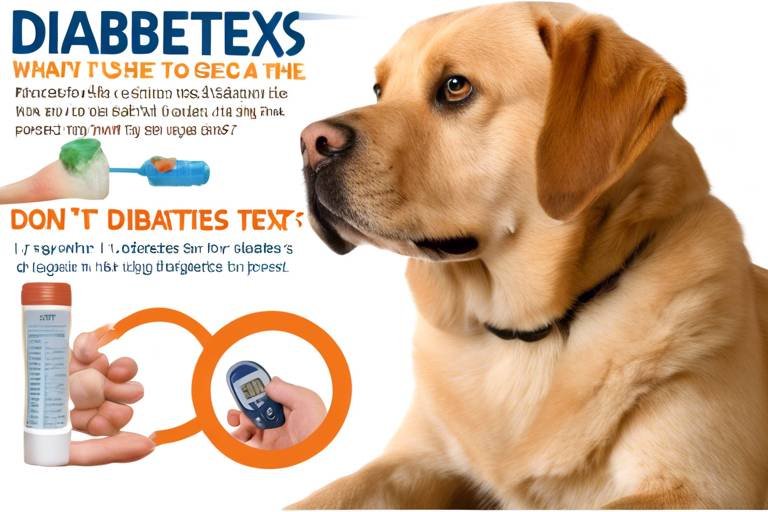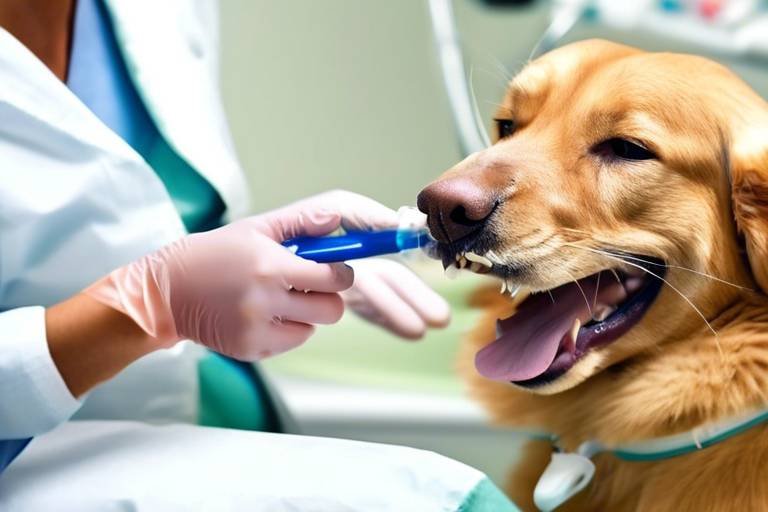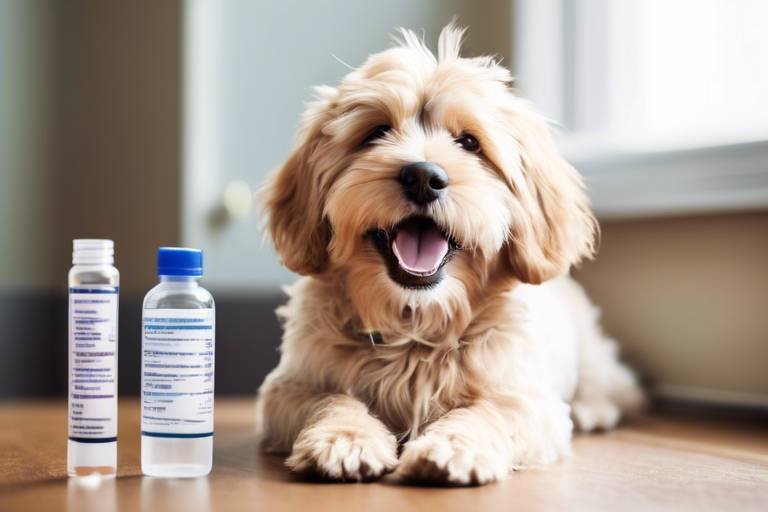How to Help Your Pet Live a Longer, Healthier Life
As pet owners, we all want our furry friends to live long, happy lives. But how do we achieve that? The journey to a longer, healthier life for your pet is filled with simple yet effective strategies. From nutrition to exercise, and even mental stimulation, there are numerous ways to enhance your pet's well-being. Imagine your pet bounding around with energy, their coat shiny and eyes bright. This vision can become a reality with the right care and attention. So, let's dive into some key areas that can significantly impact your pet's life expectancy and overall happiness!
A balanced diet is crucial for your pet's health. Just like us, pets require a variety of nutrients to thrive. Understanding their nutritional needs can prevent obesity and related health issues, contributing to a longer lifespan. Think of your pet's diet as the foundation of a house; without a solid base, everything else can crumble. Providing high-quality food tailored to your pet’s age, size, and activity level is essential. This means reading labels and possibly consulting with your veterinarian to ensure you’re making the best choices. A well-rounded diet not only keeps your pet fit but also boosts their immune system, making them less susceptible to diseases.
Physical activity is essential for maintaining your pet's health. Just like humans, pets need regular exercise to stay fit and healthy. Regular exercise helps prevent obesity, strengthens muscles, and promotes a healthy heart, ensuring your pet stays in top shape. Think of exercise as a magic elixir that keeps your pet vibrant and full of life. Whether it’s a brisk walk around the block or a playful game of fetch in the backyard, every bit of activity counts towards your pet’s well-being.
Different pets require different types of exercise. Understanding the appropriate activities for your pet can maximize their physical benefits while keeping them engaged and happy. For instance, a high-energy dog might thrive on long runs, while a cat may prefer a few rounds of chasing a feather toy. Recognizing your pet's unique needs is key to keeping them active and healthy.
For pets with limited outdoor access, indoor exercises like fetch or agility games can provide necessary physical activity while stimulating their minds. You can create an indoor obstacle course with items around your house or engage them with interactive toys that encourage movement. The goal is to keep their bodies moving and their minds sharp, even when confined indoors.
Outdoor activities such as walking, hiking, or playing in the park can enhance your pet's physical fitness and provide socialization opportunities with other animals. Just picture your dog sprinting through the grass, tail wagging, or your cat exploring the great outdoors on a leash. These experiences not only keep your pet fit but also enrich their lives with new sights, sounds, and smells.
Recognizing the signs of good health in your pet can help you monitor their well-being. Regular check-ups and being observant can lead to early detection of potential issues. Look for signs such as a shiny coat, bright eyes, and an energetic demeanor. If you notice any changes in behavior or appetite, it might be time for a visit to the vet.
Routine veterinary visits are vital for preventive care. Regular check-ups allow for vaccinations, dental care, and early detection of health problems, ensuring your pet remains in top condition. Think of your vet as your pet’s personal health coach, guiding you on the best practices to keep your furry friend thriving. These visits can catch issues before they become serious, saving both you and your pet from unnecessary stress.
Vaccinations protect pets from various diseases. Keeping their vaccination schedule up to date is essential for their long-term health and safety. Just like we get vaccinated to ward off illnesses, our pets need the same protection. Consult your veterinarian to ensure your pet is up to date on all necessary vaccines.
Oral health is often overlooked but is crucial for overall well-being. Regular dental care can prevent serious health issues and improve your pet's quality of life. Neglecting your pet's teeth can lead to painful dental diseases that can affect their heart and other organs. Simple practices like brushing their teeth or providing dental chews can make a world of difference.
Mental health is as important as physical health. Engaging your pet with toys, puzzles, and training can enhance their cognitive abilities and reduce anxiety. A mentally stimulated pet is a happy pet! Imagine your pet’s excitement as they figure out a puzzle toy or learn a new trick. This not only keeps their minds sharp but also strengthens the bond between you and your furry friend.
Training your pet not only improves behavior but also strengthens your bond. Socialization with other pets and people is essential for their emotional well-being. Think of training as a fun game that helps your pet navigate the world. The more experiences they have, the more confident and well-adjusted they become.
Using interactive toys can keep your pet mentally stimulated. These toys challenge their minds and provide entertainment, reducing boredom and destructive behavior. Whether it’s a treat-dispensing puzzle or a laser pointer for your cat, these engaging tools can keep your pet entertained for hours.
Q: How often should I take my pet to the vet?
A: Generally, pets should have a check-up at least once a year, but older pets or those with health issues may need more frequent visits.
Q: What are the signs my pet is overweight?
A: Look for difficulty in feeling their ribs, a lack of energy, and a noticeable increase in body size. Consult your vet for a proper assessment.
Q: How can I tell if my pet is happy?
A: Signs of a happy pet include wagging tails, playful behavior, and a relaxed posture. Each pet is different, so learn what makes your pet shine!

Nutrition and Diet
A balanced diet is crucial for your pet's health. Just like us, our furry friends need a variety of nutrients to thrive. Understanding their nutritional needs can prevent obesity and related health issues, contributing to a longer lifespan. Imagine feeding your pet a diet that not only satisfies their hunger but also fuels their energy and keeps their coat shiny and healthy. It’s like choosing the right fuel for a high-performance car; you wouldn’t put low-grade gas in a sports car, right?
When it comes to pet nutrition, it's essential to consider the specific needs of your pet based on their species, age, weight, and activity level. For instance, puppies and kittens require more protein and calories than older pets. Here’s a quick breakdown of what to look for in your pet’s diet:
| Life Stage | Key Nutritional Needs |
|---|---|
| Puppy/Kitten | High protein and fat for growth, essential vitamins and minerals |
| Adult | Balanced diet for maintenance, moderate protein and fat |
| Senior | Lower calories, joint support, and easily digestible ingredients |
Additionally, incorporating a mix of dry kibble and wet food can offer both hydration and variety, keeping mealtime exciting for your pet. But wait, there’s more! Don’t forget to include fresh fruits and vegetables in moderation. Many pets enjoy carrots, blueberries, and even pumpkin, which can provide added vitamins and fiber.
One of the most common issues pet owners face is obesity. It’s a silent killer that sneaks up on our beloved companions. To combat this, regular portion control is necessary. Always check the feeding guidelines on your pet food packaging, and remember that treats should only make up about 10% of your pet's daily caloric intake. Think of treats as the cherry on top of their nutritious sundae!
Lastly, always consult with your veterinarian when making significant changes to your pet's diet. They can help you tailor a nutrition plan that fits your pet’s unique needs, ensuring they stay healthy and happy. Remember, a well-fed pet is a happy pet, and their diet is the cornerstone of a long, vibrant life!

Regular Exercise
When it comes to ensuring your pet lives a long and healthy life, is a game changer. Just like us, pets need to stay active to maintain their physical health and emotional well-being. Think of exercise as the fuel that keeps their engines running smoothly. Without it, they might face a range of health issues, including obesity, heart disease, and even behavioral problems. So, how do we keep our furry friends moving and shaking? Let’s dive into the different types of exercise that can keep your pet fit and happy.
Every pet is unique, and their exercise needs can vary significantly. While some dogs may thrive on long runs, others might prefer a leisurely stroll around the block. Cats, on the other hand, might find joy in pouncing on a feather toy or climbing their favorite scratching post. Understanding the right kind of exercise for your pet is crucial in maximizing their physical benefits while keeping them engaged and entertained.
If your living situation limits outdoor access, don’t fret! There are plenty of indoor activities that can help your pet burn off some energy. For example, playing a game of fetch in a hallway or setting up an agility course using household items can be both fun and stimulating. Consider the following indoor activities:
- Fetch: A classic game that can be played in small spaces.
- Obstacle Courses: Use furniture or boxes to create a mini-agility course.
- Interactive Games: Puzzle toys that dispense treats can keep your pet mentally and physically active.
On the flip side, outdoor activities can take your pet's exercise routine to the next level. Whether it’s a brisk walk, a hike in the woods, or a playful romp in the park, outdoor adventures provide not only physical exercise but also opportunities for socialization. Imagine your dog bounding through a field, tail wagging, meeting other dogs and people—it’s a recipe for happiness! Here are some outdoor activities to consider:
- Walking: A simple yet effective way to get your pet moving.
- Hiking: Explore nature trails and enjoy the great outdoors together.
- Dog Parks: Let your dog socialize and play with other pets in a safe environment.
Recognizing the signs of a healthy pet is essential in monitoring their well-being. Regular exercise contributes to a healthy weight, shiny coat, and overall vitality. Keep an eye out for these indicators:
- Energy Levels: A well-exercised pet will have plenty of energy and enthusiasm.
- Healthy Weight: Regular activity helps maintain a healthy weight.
- Playfulness: A happy pet is often a playful pet!
By ensuring your pet gets the right amount of exercise, you’re not just adding years to their life; you’re adding life to their years. So, lace up those walking shoes, grab that leash, and let’s get moving!
Q: How much exercise does my pet need?
A: The amount of exercise needed varies by species, breed, and age. Generally, dogs require at least 30 minutes to 2 hours of exercise daily, while cats can benefit from several short play sessions throughout the day.
Q: What are some signs my pet is getting too much exercise?
A: Watch for signs like excessive panting, limping, or reluctance to continue playing. If your pet seems fatigued or disinterested, it may be time to cut back.
Q: Can indoor pets get enough exercise?
A: Absolutely! Indoor pets can engage in various activities like fetch, climbing, and interactive toys to stay active and stimulated.
Types of Exercise
When it comes to keeping your furry friends fit and happy, understanding the they need is crucial. Just like humans, pets have their own unique requirements based on their breed, age, and energy levels. Imagine trying to run a marathon when all you really want is a leisurely stroll in the park! The same goes for our pets. Tailoring their exercise routine not only maximizes their physical benefits but also keeps them engaged and, most importantly, happy.
For instance, dogs are generally more active than cats and thrive on outdoor adventures. They love to chase after balls, run alongside their owners, and engage in playful wrestling. On the other hand, cats might prefer activities that stimulate their hunting instincts, such as pouncing on feather toys or chasing laser pointers. It’s essential to recognize these differences and create a balanced exercise regimen that meets their needs.
So, what are the best types of exercise for your pet? Here are some suggestions:
- For Dogs:
- Walking: A daily walk is a must for dogs. It helps them explore their environment and socialize with other dogs.
- Fetch: This classic game not only gets their heart racing but also strengthens your bond with them.
- Agility Training: Setting up an obstacle course in your backyard can be a fun way to challenge your dog physically and mentally.
- For Cats:
- Pouncing Games: Use toys that mimic the movement of prey to keep your cat engaged.
- Interactive Play: Engage your cat with string or feather toys to stimulate their hunting instincts.
- Climbing: Providing cat trees or shelves can encourage climbing, which is great exercise for them.
Remember, the goal is to make exercise enjoyable. Think of it as playtime rather than a chore! Incorporating a mix of indoor and outdoor activities can keep your pet excited about exercising. For example, after a long day at work, taking your dog for a walk in the park can be a refreshing way for both of you to unwind. And for indoor pets, creating a fun play area with various toys can ensure they stay active even when they can’t go outside.
Ultimately, the key is to observe your pet's behavior and adjust their exercise routine accordingly. If they're panting heavily or seem disinterested, it might be time to change things up. Keeping a close eye on their energy levels and preferences will help you create a personalized exercise plan that promotes a longer, healthier, and happier life for your beloved pet!
- How much exercise does my dog need?
Generally, dogs need at least 30 minutes to 2 hours of exercise daily, depending on their breed and age. - Can my cat get enough exercise indoors?
Absolutely! Indoor play with interactive toys can keep your cat engaged and active. - What signs indicate my pet is getting enough exercise?
Signs include a healthy weight, good energy levels, and a happy demeanor. If they seem restless or destructive, they may need more activity.
Indoor Activities
When the weather outside is frightful, or if you simply prefer to keep your furry friend indoors, there are countless that can keep them physically active and mentally stimulated. Think of your home as a playground! You can transform any space into a fun zone for your pet. For instance, playing a game of fetch in your living room can be just as exhilarating as a game in the park, provided you have enough space and a soft toy to avoid any accidents. Remember, a tired pet is a happy pet!
One fantastic indoor activity is to set up an agility course. You can use cushions, chairs, and other furniture to create hurdles and tunnels. This not only challenges your pet physically but also engages their mind as they navigate through the course. Imagine your dog leaping over a pillow like it’s a mountain! You can even time their runs and encourage them to beat their own records, turning it into a fun competition.
For pets that enjoy a challenge, consider interactive toys that require problem-solving skills. These toys often have hidden treats that your pet must figure out how to access. It’s like a treasure hunt right in your living room! Not only does this keep them busy, but it also stimulates their cognitive abilities, preventing boredom and the destructive behavior that sometimes follows.
Another great option is to engage in hide and seek. You can hide somewhere in your home and call your pet, rewarding them with treats when they find you. This game not only strengthens your bond but also taps into their natural instincts to seek out and explore. Plus, it’s a fantastic way to get some exercise in for both you and your pet!
Lastly, don’t underestimate the power of a simple game of tug-of-war. This classic game can be played with a sturdy rope toy or even a soft towel. It’s a great way to engage your pet in physical activity while also allowing them to use their strength. Just remember to let them win sometimes; it boosts their confidence and keeps the game fun!
In summary, indoor activities can be just as rewarding as outdoor adventures. With a little creativity and enthusiasm, you can ensure that your pet stays active, happy, and healthy regardless of the weather outside. So, the next time the rain pours or the snow falls, don’t fret! Your home can become a vibrant playground filled with fun and excitement for your beloved pet.
- What are some safe indoor activities for pets? Indoor fetch, agility courses, interactive toys, and hide and seek are excellent choices.
- How can I keep my pet mentally stimulated indoors? Use puzzle toys, engage in training sessions, or introduce new games to challenge their minds.
- Is it necessary to exercise pets indoors? Yes, regular exercise is crucial for their physical and mental health, even when indoors.
Outdoor Adventures
When it comes to keeping your pet happy and healthy, nothing beats the thrill of outdoor adventures! Imagine your furry friend’s excitement as they dash through the grass, sniffing every blade and chasing after the occasional butterfly. Outdoor activities are not just fun; they’re essential for your pet’s physical and mental well-being. But what types of outdoor adventures should you consider? Let’s explore some fantastic options!
First and foremost, regular walks are a must. They help maintain your pet's weight and strengthen their muscles. Plus, walks are a great way for you and your pet to bond. While a simple stroll around the neighborhood is beneficial, consider varying your routes to keep things interesting. You might even discover new parks or trails that you both can enjoy! Walking is like a treasure hunt for your pet, full of new scents and sights that stimulate their senses.
Then there are the exhilarating hikes! Taking your dog on a hike is like giving them a mini-vacation. The change of scenery, the fresh air, and the opportunity to explore nature can do wonders for their mood. Just think about it: your dog bounding up a hill, tail wagging with glee, as they take in the breathtaking views. But remember, safety first! Always ensure your pet is physically fit for hiking and keep them on a leash to protect them from potential dangers.
Another exciting option is visiting a dog park. These parks are like social clubs for pets, where they can meet and play with other dogs. It's a fantastic way for your pet to engage in socialization, which is crucial for their emotional health. Watching them frolic and make new friends can be incredibly rewarding. Just be sure to supervise their interactions to ensure everyone is playing nicely.
As you plan your outdoor adventures, consider the weather and your pet’s preferences. Some pets thrive in cooler temperatures, while others love the sun. Always bring water and snacks to keep them hydrated and energized. And don’t forget the essentials: a leash, waste bags, and perhaps a favorite toy for added fun!
In summary, outdoor adventures are not just a luxury; they are a necessity for your pet’s happiness and health. Whether it’s a leisurely walk, a vigorous hike, or a fun day at the dog park, these activities provide essential exercise, mental stimulation, and socialization opportunities. So, grab that leash and head outside—your pet will thank you for it!
- How often should I take my pet for outdoor activities? Ideally, aim for at least 30 minutes of exercise daily, but adjust based on your pet's breed, age, and health condition.
- What should I bring for outdoor adventures? Always bring water, snacks, a leash, waste bags, and any necessary safety gear.
- Is it safe to let my pet off-leash? Only in designated areas and if your pet has reliable recall. Always prioritize their safety.
Signs of a Healthy Pet
This article explores various strategies and practices that can enhance your pet's well-being, ensuring they enjoy a longer, healthier life filled with happiness and vitality.
A balanced diet is crucial for your pet's health. Understanding their nutritional needs can prevent obesity and related health issues, contributing to a longer lifespan.
Physical activity is essential for maintaining your pet's health. Regular exercise helps prevent obesity, strengthens muscles, and promotes a healthy heart, ensuring your pet stays fit.
Different pets require different types of exercise. Understanding the appropriate activities for your pet can maximize their physical benefits while keeping them engaged and happy.
For pets with limited outdoor access, indoor exercises like fetch or agility games can provide necessary physical activity while stimulating their minds.
Outdoor activities such as walking, hiking, or playing in the park can enhance your pet's physical fitness and provide socialization opportunities with other animals.
Recognizing the signs of good health in your pet is crucial for monitoring their well-being and ensuring they live a long, happy life. Just like us, pets exhibit certain behaviors and physical traits that can indicate their overall health status. For instance, a healthy pet typically has a shiny coat, bright eyes, and a lively demeanor. If you notice your furry friend is more lethargic than usual or has a dull coat, it might be time for a check-up.
Here are some key signs to look out for:
- Appetite: A sudden change in appetite, whether increased or decreased, can be a red flag.
- Weight: Maintaining a healthy weight is essential. Regularly monitor their weight to avoid obesity or underweight issues.
- Energy Levels: A healthy pet is usually active and playful. If they seem tired or disinterested in activities they once enjoyed, it could indicate a problem.
- Grooming Habits: Pets that groom themselves regularly are often in good health. A lack of grooming can signify stress or health issues.
- Bathroom Habits: Regular and normal bathroom habits are a sign of good health. Watch for any changes in frequency or appearance.
Additionally, regular veterinary visits are essential for preventive care. Keeping an eye on these signs can lead to early detection of potential issues, allowing for timely intervention and treatment. Remember, your pet relies on you to notice these changes. Just like a good friend would, be observant and proactive about their health!
Routine veterinary visits are vital for preventive care. Regular check-ups allow for vaccinations, dental care, and early detection of health problems, ensuring your pet remains in top condition.
Vaccinations protect pets from various diseases. Keeping their vaccination schedule up to date is essential for their long-term health and safety.
Oral health is often overlooked but is crucial for overall well-being. Regular dental care can prevent serious health issues and improve your pet's quality of life.
Mental health is as important as physical health. Engaging your pet with toys, puzzles, and training can enhance their cognitive abilities and reduce anxiety.
Training your pet not only improves behavior but also strengthens your bond. Socialization with other pets and people is essential for their emotional well-being.
Using interactive toys can keep your pet mentally stimulated. These toys challenge their minds and provide entertainment, reducing boredom and destructive behavior.
Q1: How often should I take my pet to the vet?
A: It's generally recommended to take your pet for a check-up at least once a year. However, older pets or those with health issues may require more frequent visits.
Q2: What should I feed my pet for the best nutrition?
A: Consult your veterinarian for specific recommendations based on your pet's age, weight, and health status. A balanced diet tailored to your pet's needs is vital.
Q3: How can I tell if my pet is overweight?
A: You can check your pet's weight against breed standards or consult your vet. Look for a visible waist and feel for ribs without excessive fat covering.
Q4: What are some signs of dental issues in pets?
A: Bad breath, red gums, difficulty eating, and excessive drooling can all indicate dental problems. Regular dental check-ups are essential!

Regular Veterinary Check-ups
Routine veterinary visits are not just a chore; they are a vital component of your pet's overall health and well-being. Just like we need our annual check-ups to catch any potential issues early, our furry friends benefit immensely from regular visits to the vet. These appointments allow for crucial preventive care, ensuring that your pet remains in top condition throughout their life.
During these check-ups, your veterinarian will perform a thorough examination of your pet, checking for any signs of illness or discomfort. They will assess your pet's weight, coat condition, and overall demeanor, which can provide invaluable insights into their health. Additionally, these visits are the perfect opportunity to discuss any behavioral changes or concerns you might have noticed at home.
One of the key aspects of regular veterinary check-ups is the administration of vaccinations. Vaccinations protect pets from various diseases, many of which can be severe or even fatal. Keeping your pet's vaccination schedule up to date is essential for their long-term health and safety. For example, core vaccines such as rabies and distemper are critical for all pets, while others may be recommended based on your pet's lifestyle and risk factors.
Besides vaccinations, dental health is another area that often gets overlooked. Did you know that dental disease is one of the most common health issues in pets? Regular dental check-ups can help prevent serious health problems associated with poor oral hygiene, such as infections that can affect the heart and kidneys. Your veterinarian can provide professional cleanings and offer advice on maintaining your pet's oral health at home.
To help you understand the importance of these check-ups, let’s look at some of the preventive measures that can be taken during a routine visit:
| Preventive Measure | Description |
|---|---|
| Vaccinations | Protects against various diseases |
| Dental Health | Professional cleaning and oral care advice |
| Weight Management | Monitoring to prevent obesity |
| Parasite Control | Testing and treatment for fleas, ticks, and worms |
In conclusion, regular veterinary check-ups are essential for maintaining your pet's health. They help in early detection of potential health issues, ensuring your furry friend leads a longer, healthier life. So, don’t wait for your pet to show signs of illness; make those appointments a priority and keep your companion thriving!
- How often should I take my pet to the vet? - Generally, adult pets should see the vet at least once a year, while puppies and kittens may require more frequent visits.
- What should I expect during a check-up? - Expect a thorough examination, discussions about vaccinations, dental care, and any behavioral concerns you might have.
- Are vaccinations necessary every year? - Some vaccines require annual boosters, while others may be effective for several years. Consult your vet for your pet’s specific needs.
Vaccination Importance
This article explores various strategies and practices that can enhance your pet's well-being, ensuring they enjoy a longer, healthier life filled with happiness and vitality.
A balanced diet is crucial for your pet's health. Understanding their nutritional needs can prevent obesity and related health issues, contributing to a longer lifespan.
Physical activity is essential for maintaining your pet's health. Regular exercise helps prevent obesity, strengthens muscles, and promotes a healthy heart, ensuring your pet stays fit.
Different pets require different types of exercise. Understanding the appropriate activities for your pet can maximize their physical benefits while keeping them engaged and happy.
For pets with limited outdoor access, indoor exercises like fetch or agility games can provide necessary physical activity while stimulating their minds.
Outdoor activities such as walking, hiking, or playing in the park can enhance your pet's physical fitness and provide socialization opportunities with other animals.
Recognizing the signs of good health in your pet can help you monitor their well-being. Regular check-ups and being observant can lead to early detection of potential issues.
Routine veterinary visits are vital for preventive care. Regular check-ups allow for vaccinations, dental care, and early detection of health problems, ensuring your pet remains in top condition.
Vaccinations are one of the most important aspects of your pet's health care. They serve as a shield against a range of potentially fatal diseases. Just like how we humans get our flu shots, pets need their vaccines to keep them safe from illnesses that can be serious or even life-threatening. For instance, diseases like rabies, parvovirus, and distemper are not just scary words; they can have devastating effects on your furry friend.
Consider this: a simple vaccination can save your pet from a painful illness that could lead to costly treatments or, worse, loss of life. Keeping your pet's vaccination schedule up to date is essential for their long-term health and safety. It's like giving them a protective armor that helps them fight off infections. Here are some key points to remember:
- Core Vaccines: These are essential for all pets, including rabies and distemper.
- Non-Core Vaccines: Depending on your pet's lifestyle, additional vaccines may be recommended, such as Bordetella for dogs that frequent dog parks.
- Regular Updates: Vaccination schedules vary by age and health status, so regular veterinary visits are crucial.
Moreover, vaccinations not only protect your pet but also contribute to public health by preventing the spread of diseases. Imagine a world where pets and humans coexist without the threat of transmissible diseases; that's the goal of vaccinations. So, when in doubt, consult your veterinarian about what vaccines are necessary for your pet. They can provide personalized recommendations based on your pet's age, breed, and lifestyle, ensuring that your furry friend is always protected.
Oral health is often overlooked but is crucial for overall well-being. Regular dental care can prevent serious health issues and improve your pet's quality of life.
Mental health is as important as physical health. Engaging your pet with toys, puzzles, and training can enhance their cognitive abilities and reduce anxiety.
Training your pet not only improves behavior but also strengthens your bond. Socialization with other pets and people is essential for their emotional well-being.
Using interactive toys can keep your pet mentally stimulated. These toys challenge their minds and provide entertainment, reducing boredom and destructive behavior.
- How often should my pet be vaccinated? - Generally, pets should receive vaccinations annually, but this can vary based on the vaccine type and your pet's health.
- Are there side effects to vaccinations? - Most pets experience mild side effects, such as soreness at the injection site or a slight fever. Serious reactions are rare.
- Can I vaccinate my pet at home? - It's best to have vaccinations administered by a veterinarian to ensure safety and proper handling.
Dental Care
When it comes to our furry friends, often takes a backseat to other health considerations. However, just like humans, pets can suffer from a variety of dental issues that can significantly impact their overall health and quality of life. Neglecting your pet's oral hygiene can lead to serious problems such as gum disease, tooth loss, and even infections that can spread to vital organs. This is why establishing a regular dental care routine is essential for your pet's well-being.
So, how can you ensure your pet maintains a healthy mouth? First and foremost, regular brushing is key. Just imagine brushing your own teeth; it's a habit that keeps your mouth fresh and free from harmful bacteria. The same goes for your pet! Aim to brush your pet's teeth at least two to three times a week. Use a toothbrush and toothpaste specifically designed for pets, as human products can be harmful to them. If your pet is resistant to brushing, don't worry! There are other methods to promote good dental health.
In addition to brushing, consider incorporating dental treats and toys into your pet's routine. Many of these products are designed to help reduce plaque and tartar buildup while satisfying your pet's natural urge to chew. You can also explore dental chews and specially formulated dental diets that can aid in maintaining oral hygiene. Here’s a quick look at some common dental care options:
| Dental Care Option | Description |
|---|---|
| Toothbrush and Toothpaste | Use products specifically made for pets to avoid harmful ingredients. |
| Dental Chews | Chewable treats designed to reduce plaque and tartar. |
| Dental Diets | Specially formulated foods that promote oral health. |
| Professional Cleanings | Regular vet visits for thorough dental cleanings under anesthesia. |
Another crucial aspect of dental care is scheduling regular veterinary check-ups. Your veterinarian can perform professional cleanings and check for any signs of dental disease that may not be visible to the naked eye. During these visits, they can also provide you with tailored advice on how to best care for your pet's teeth based on their specific needs.
It's important to be proactive rather than reactive when it comes to your pet's dental health. Just as you wouldn’t wait until you have a toothache to see a dentist, don’t wait for your pet to show signs of discomfort before addressing their dental care. Regular maintenance can prevent serious health issues down the line, ensuring your pet enjoys a long, happy, and healthy life.
- How often should I brush my pet's teeth? Aim for at least two to three times a week, but daily brushing is ideal.
- What if my pet doesn't like having their teeth brushed? Start slowly, use flavored toothpaste, and consider dental treats as an alternative.
- Are dental chews effective? Yes, many dental chews are designed to help reduce plaque and tartar buildup.
- How can I tell if my pet has dental problems? Look for signs like bad breath, difficulty eating, swollen gums, or excessive drooling.

Mental Stimulation
Mental stimulation is just as crucial as physical activity when it comes to keeping your pet healthy and happy. Think about it: just like humans, pets can get bored, anxious, and even depressed if their minds aren’t engaged. Providing your furry friend with a variety of stimulating activities can not only help improve their cognitive abilities but also enhance their overall quality of life. So, how can you keep that little brain of theirs sharp and active? Let’s dive into some fun and effective strategies!
One of the easiest ways to provide mental stimulation is through interactive toys. These toys are designed to challenge your pet’s problem-solving skills and keep them entertained for hours. For instance, puzzle toys that dispense treats when solved can turn snack time into an exciting game. Imagine your dog or cat working hard to figure out how to get that tasty reward—it's like a mini workout for their brain! Not only do these toys reduce boredom, but they also promote healthy chewing habits, which can help keep their teeth clean.
Training and socialization play a significant role in your pet's mental health as well. Incorporating training sessions into your routine not only reinforces good behavior but also deepens the bond you share with your pet. Teaching them a new trick or command can be incredibly rewarding for both of you. Plus, the mental challenge of learning something new keeps their minds active. Don't forget about socialization! Introducing your pet to new environments, people, and other animals can help them become more adaptable and confident. Think of it as a social workout—just like you might feel more energized after a good chat with friends, your pet will thrive from these interactions.
Another great way to stimulate your pet's mind is through engaging playtime. Whether it’s playing fetch, hide-and-seek, or even setting up an agility course in your backyard, these activities can provide both physical and mental challenges. For indoor pets, consider creating a scavenger hunt with their favorite toys or treats. Hide them around your home and let your pet use their nose and instincts to find them. It’s like a treasure hunt that keeps them engaged and entertained!
Lastly, don’t underestimate the power of simple interactions. Just spending time petting, grooming, or talking to your pet can provide them with the mental stimulation they crave. Animals are incredibly perceptive, and they thrive on your attention and affection. So, the next time you’re lounging on the couch, invite your pet to join you for some quality time. It’s a win-win situation!
In summary, keeping your pet mentally stimulated is essential for their overall well-being. By incorporating interactive toys, training, socialization, and engaging playtime into their routine, you can help ensure that your furry friend remains happy, healthy, and vibrant. Remember, a mentally stimulated pet is a happy pet!
- What are some signs my pet needs more mental stimulation? If your pet is exhibiting destructive behavior, excessive barking, or seems lethargic, they may need more mental engagement.
- How often should I engage my pet in mental activities? Aim for at least 15-30 minutes of mental stimulation daily, but adjust based on your pet's energy levels and preferences.
- Can mental stimulation help with anxiety in pets? Yes! Engaging your pet's mind can reduce anxiety and help them feel more secure and relaxed.
Training and Socialization
Training and socialization are not just about teaching your pet to sit or stay; they are vital components of your pet's overall well-being. Imagine your furry friend as a sponge, soaking up experiences and lessons that shape their behavior and personality. When you invest time in training, you’re not only teaching commands but also building a solid foundation of trust and communication between you and your pet. This relationship is akin to a dance where both partners must learn the steps to move harmoniously together.
Socialization, on the other hand, is like opening a window to the world for your pet. It exposes them to various environments, sounds, and other animals, which can significantly reduce anxiety and fearfulness. Think about it: a well-socialized pet is a confident pet! They are more likely to interact positively with humans and other animals, making outings to the park or the vet a breeze rather than a battle.
So, how do you effectively train and socialize your pet? First, start with positive reinforcement techniques. Reward-based training, where you offer treats or praise for good behavior, is not only effective but also strengthens your bond. For example, if your dog sits on command, reward them with a tasty treat and lots of affection. This approach creates a positive association with learning and encourages them to repeat the behavior.
Next, consider incorporating socialization into your daily routine. Take your pet for walks in different neighborhoods or visit pet-friendly stores. Allow them to meet new people and other pets in a controlled environment. For instance, dog parks are great places to let your pup interact with others, but ensure they are comfortable and not overwhelmed. Gradually introducing them to new experiences will help them become well-rounded companions.
Here’s a quick table summarizing some effective training and socialization tips:
| Training Tips | Socialization Tips |
|---|---|
| Use positive reinforcement. | Expose your pet to different environments. |
| Be consistent with commands. | Encourage interactions with new people. |
| Keep training sessions short and fun. | Visit pet-friendly places regularly. |
Remember, training and socialization are ongoing processes. Just like us, our pets continue to learn and adapt throughout their lives. Make it a habit to engage with your pet daily, whether through training exercises or social outings. The more experiences you provide, the more confident and well-adjusted your pet will become.
In conclusion, think of training and socialization as the keys to unlocking your pet's potential. A well-trained and socialized pet is not only a joy to have around but also a healthier and happier companion. So, grab those treats, hit the park, and start building a stronger bond with your furry friend today!
- How often should I train my pet? It's best to train your pet in short, frequent sessions—about 5 to 10 minutes a day is ideal.
- What age should I start socializing my pet? Begin socializing your pet as early as possible, ideally between 3 to 14 weeks of age for puppies, but older pets can also benefit from socialization.
- Can training help with behavioral issues? Yes! Training can address many behavioral problems, helping your pet learn appropriate behaviors and responses.
Interactive Toys
This article explores various strategies and practices that can enhance your pet's well-being, ensuring they enjoy a longer, healthier life filled with happiness and vitality.
A balanced diet is crucial for your pet's health. Understanding their nutritional needs can prevent obesity and related health issues, contributing to a longer lifespan.
Physical activity is essential for maintaining your pet's health. Regular exercise helps prevent obesity, strengthens muscles, and promotes a healthy heart, ensuring your pet stays fit.
Different pets require different types of exercise. Understanding the appropriate activities for your pet can maximize their physical benefits while keeping them engaged and happy.
For pets with limited outdoor access, indoor exercises like fetch or agility games can provide necessary physical activity while stimulating their minds.
Outdoor activities such as walking, hiking, or playing in the park can enhance your pet's physical fitness and provide socialization opportunities with other animals.
Recognizing the signs of good health in your pet can help you monitor their well-being. Regular check-ups and being observant can lead to early detection of potential issues.
Routine veterinary visits are vital for preventive care. Regular check-ups allow for vaccinations, dental care, and early detection of health problems, ensuring your pet remains in top condition.
Vaccinations protect pets from various diseases. Keeping their vaccination schedule up to date is essential for their long-term health and safety.
Oral health is often overlooked but is crucial for overall well-being. Regular dental care can prevent serious health issues and improve your pet's quality of life.
Mental health is as important as physical health. Engaging your pet with toys, puzzles, and training can enhance their cognitive abilities and reduce anxiety.
Interactive toys are a fantastic way to keep your furry friend mentally stimulated and entertained. These toys are designed to engage your pet's mind, challenging them to think and solve problems. Just like humans, pets can get bored too, and boredom can lead to destructive behavior. By introducing interactive toys into their playtime, you can keep their minds sharp and their spirits high.
Imagine a dog that has to figure out how to get a treat from a puzzle toy. It’s not just a game; it’s a workout for their brain! Similarly, cats can benefit from toys that mimic the movement of prey, encouraging their natural hunting instincts. Here are some types of interactive toys that you might consider:
- Puzzle Feeders: These toys require pets to solve a puzzle to access their food or treats, providing both mental and physical stimulation.
- Interactive Laser Toys: For cats, laser pointers or automatic laser toys can keep them engaged in chasing and pouncing.
- Treat-Dispensing Balls: These rolling toys dispense treats as your pet plays with them, encouraging them to stay active while rewarding them.
When selecting interactive toys, consider your pet's preferences and activity level. Some pets may prefer toys that they can chew or paw at, while others might enjoy more complex puzzles. The key is to keep their playtime varied and interesting. Just like how we enjoy switching between a good book and a thrilling movie, pets also appreciate a mix of activities. By incorporating interactive toys into their routine, you’re not just providing entertainment; you’re enriching their lives and helping them develop better cognitive skills.
Q: How often should I change my pet's toys?
A: It's a good idea to rotate your pet's toys every few weeks to keep their interest alive. Introducing new toys or bringing back old favorites can make playtime exciting again.
Q: Are interactive toys suitable for all pets?
A: Yes, most pets can enjoy interactive toys, but it's essential to choose the right type based on their age, size, and activity level.
Q: Can interactive toys help with behavioral issues?
A: Absolutely! Interactive toys can reduce boredom and anxiety, which often lead to destructive behaviors in pets.
Frequently Asked Questions
- What should I feed my pet for a balanced diet?
Feeding your pet a balanced diet involves providing a mix of high-quality protein, carbohydrates, fats, vitamins, and minerals. It's essential to choose pet food that meets their specific age, size, and health needs. Consult your veterinarian for tailored advice on the best diet for your furry friend.
- How much exercise does my pet need?
The amount of exercise your pet needs varies by species, age, and breed. Generally, dogs require at least 30 minutes to 2 hours of exercise daily, while cats may need around 15-30 minutes of playtime. Regular walks, fetch, or interactive play can help keep them fit and healthy.
- How can I tell if my pet is healthy?
Signs of a healthy pet include a shiny coat, bright eyes, normal appetite, and a playful demeanor. Regular check-ups with the vet can help monitor their health, and being observant of any changes in behavior or appearance can lead to early detection of potential issues.
- Why are regular veterinary check-ups important?
Regular veterinary check-ups are crucial for preventive care. They help ensure your pet receives necessary vaccinations, dental care, and early detection of health problems. Routine visits can significantly contribute to a longer, healthier life for your pet.
- What vaccinations does my pet need?
Your pet's vaccination needs depend on their species, age, and lifestyle. Common vaccinations for dogs include rabies, distemper, and parvovirus, while cats may need rabies, feline distemper, and feline leukemia. Always discuss with your vet to keep your pet's vaccination schedule up to date.
- How important is dental care for my pet?
Dental care is vital for your pet's overall health. Poor oral hygiene can lead to serious health issues, including heart disease. Regular teeth brushing, dental treats, and professional cleanings can help maintain your pet's oral health and improve their quality of life.
- What are some ways to keep my pet mentally stimulated?
Mental stimulation is crucial for your pet's well-being. You can keep them engaged through interactive toys, puzzles, training sessions, and socialization with other pets. Regularly changing their toys and introducing new activities can also help reduce boredom and anxiety.
- How can training improve my pet's behavior?
Training not only enhances your pet's behavior but also strengthens your bond. It helps them understand commands and expectations, leading to a well-mannered pet. Positive reinforcement techniques, such as treats and praise, can make training enjoyable for both you and your furry companion.
- What are interactive toys, and how do they benefit my pet?
Interactive toys are designed to challenge your pet's mind and keep them engaged. They can include puzzle feeders, treat-dispensing toys, or toys that require problem-solving skills. These toys help reduce boredom, prevent destructive behavior, and promote mental well-being.



















